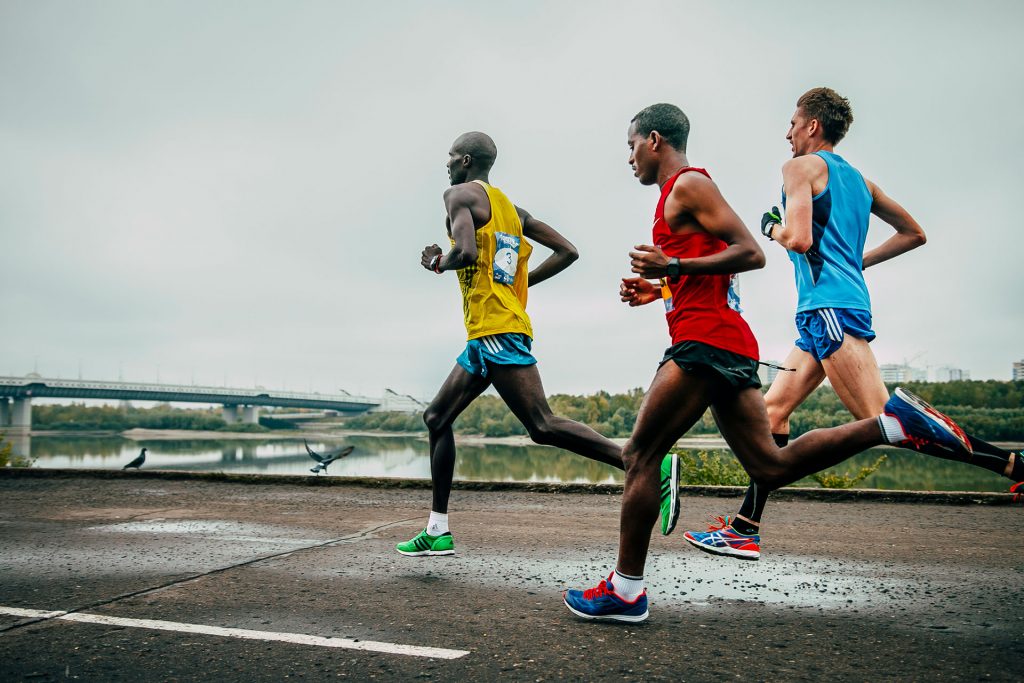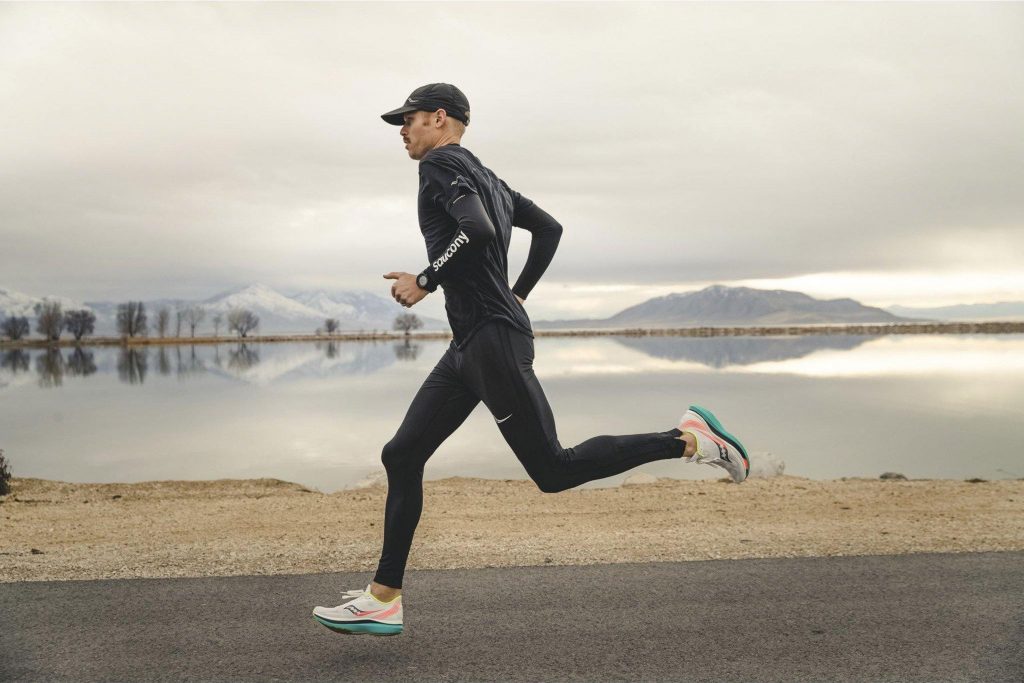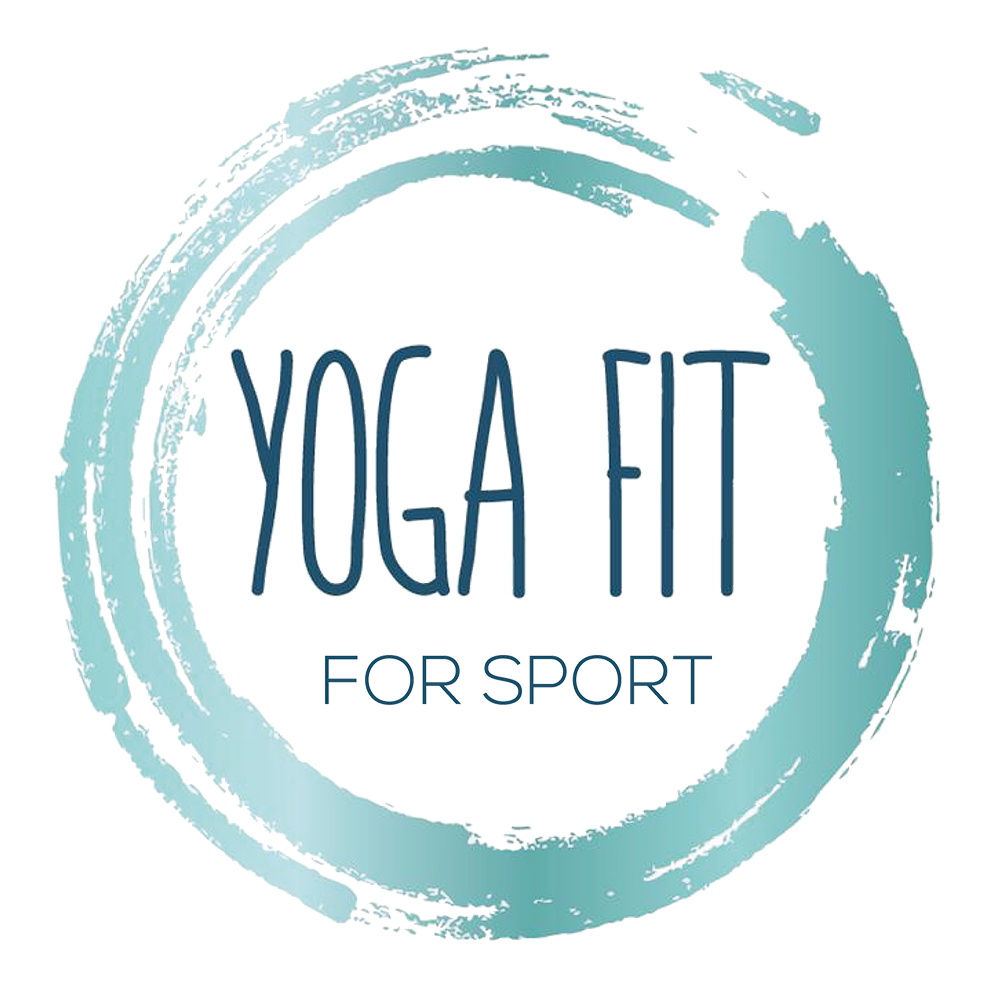Yoga Fit for Sport
Run
We have all marvelled at the efficiency, grace and speed of the elite runners of the world. How they get there is a mix of biomechanics, technique and of course, a serious amount of training. With those big miles, comes stiffness in the legs. The body is adapting to the demand placed on it, and this is a good thing. Running is a challenging sport with a high level of repetitive force. We need to be strong!
More specifically, the body adapts to the bouncing action of running. The tendons become springy to allow more elastic recoil. The more of it we have, the less muscular contraction is required and therefore, running efficiency increases. It’s unsurprising then, that runners tend to shy away from a lot of stretching. However, there is a point of diminishing returns with just tightening everything. Studies have shown that there is an optimum degree of flexibility and stiffness required to maximise running economy. Yoga can be used very effectively to achieve this delicate balance.
Running Biomechanics
Our feet are hugely important when it comes to running. Yet, these engineering masterpieces are often overlooked when it comes to training. The three arches of the foot act like springs, propelling us forward due to elastic recoil. This only happens if the foot and arches are strong. If they’re not, we don’t benefit from the spring-like propulsion forward and we’re also more at risk of injuries such as plantar fasciitis or achilles tendonitis.
The big toe is responsible for a lot of the push-off power from the back foot at toe-off point. The stronger and more mobile the big toe joint is, the better it propels us forward. Ideally runners should be able to raise it off the ground somewhere between 30-50 degrees unaided. If a runner lacks this mobility, there will be inefficiency and a lack of power, as they will likely compensate by putting more load on the outside of the foot, or the rest of the toes.
Since so much weight is transferred to the foot on landing, it needs to be healthy and strong. Poor foot biomechanics will also have consequences up the chain. For example, an over-pronated foot will likely cause the ankle, knee and hip to compensate and throw them out of alignment and at greater risk of injury. Therefore, it’s wise to make sure the base is right, so that the entire leg is more likely to function well.
The tibias (posterior and anterior) and fibularis (longs and brevis) muscles are often referred to as the stirrup tendons. These muscles work in a coordinated way to distribute weight through the foot, help maintain balance and support the ankles and arches of the feet. Strengthening them at their end range is wise in order to allow greater ankle range of motion.This in turn makes them more resilient and less susceptible to sprains.
Shin splints are a common issue for runners. The nature of running is that the back of the leg is worked more than the front. Therefore, it’s important to condition the tissues around the shin to be able to cope with the demands of running. Overworked, tight and/or weak calf muscles can also be a contributing factor of shin splints. Dorsiflexion exercises can help reduce the risk of shin splints. Mobilising the ankles through dorsiflexion work is also useful in hill running, where a greater range of motion is needed.


Since running is a repetitive movement, any joint misalignment can cause issues over time and increase the likelihood of cartilage damage. This is particularly true of the knee. Runners knee is a common complaint and is usually a biomechanical issue, due to maltracking. Assuming foot and ankle biomechanics are sound, the ITB isn’t too tight and there isn’t a tendency to heel strike, weakness in the quads should be explored as a potential cause. The key knee stabilisers of the quads are the vastus medialis oblique (VMO) and vastus lateralis (VL). Strengthening these muscles and making sure one isn’t more over-developed than the other can help avoid knee issues.
The entire backline of the body, the achilles, calves, hamstrings, glutes and the back need to be strong, short and springy. This helps to achieve elastic recoil and running economy. The glutes in particular are a powerful muscle group that a runner will want to keep strong, but they also need to be mobile so runners are able to access that power. Glute mobility along with strong hip flexors helps to drive the knee high, which is especially important for sprinting.
If we consider the hip flexors of the back leg at toe-off point, we need a lot of extension; ideally 18 degrees or more. This kind of mobility will allow a runner to maintain forward momentum. If the hip flexors are too short then runners will lose speed as they are essentially pulling themselves up rather than forward at toe-off point.
The ITB is an area that tends to gets tight for runners. This is largely due to the repetitive nature of working purely in the sagittal plane. It usually benefits from some gentle mobilisation work. The ITB needs a certain amount of tightness, but too much can lead to a tilting of the patella, causing knee issues.
The ideal angle of hip to shoulder is 5-10 degrees. This will feel as if an imaginary cord is pulling us forward from the chest. This is often referred to the forward lean and why long distance running is essentially controlled falling forward. To maintain this shape while running, the serratus anterior, posterior and pectoralis muscles should be engaged. These help to keep the shoulders back, expand the ribcage and support the breathing function.
Power to the legs and arms is initiated in the core. A strong core also helps a runner to maintain the forward lean posture and avoids any inefficiency, or wastage of power from too much of a swinging motion.
Strong, mobile and visible arches on the feet are essential for healthy and sustainable running. These can be trained with plantar fascia exercises. Being barefoot, or wearing low profile shoes with enough room in the toe-box area will also help. Training the feet in these ways, means that orthotics should not be needed. Devices such as these, or extremely supportive shoes with a narrow toe-box, only serve to weaken feet further in the long term. It’s much more effective to train the feet to be strong of themselves. Strong arches also mean we get the spring like action of elastic recoil, so they are well worth training.
Big toe mobility should also be trained in order to get optimal extension and power off the back foot at toe-off point. This can be done by simply pulling the big toes up unaided. Another option is to loop the the fingers around the big toe and apply some resistance. This is enough to train it to remember the feeling of pushing away strongly. It’s a small action, but helpful for getting power off the back foot.
Proprioception of the feet and toes can be trained in yoga by the nature of being barefoot, balancing, shifting our weight and moving our bodies in more diverse ways. Not only does this improve our running thanks to improved biomechanics, balance, awareness of the foot and the terrain underfoot, but it also reduces the risk of injuries such as plantar fasciitis and the risk of falls and sprains. Due to the reciprocal relationship of the foot, ankle, knee and hip, with a strong base and mobile, healthy feet, we are also reducing the risk of issues further up the chain.
To minimise the risk of shin splints, conditioning the muscles and tissues around this area is important. This can be done with dorsiflexion exercises and engagement of the tibias anterior. Occasionally tight and/or weak calf muscles are the cause of shin splints. A delicate balance of flexibility and strength is needed here for the calf and soleus muscles. We need some amount of freedom in them to limit the risk of shin splints, but not so much that we lose the tightness required for strength and speed.
The stirrup muscles are important stabilisers of the foot and ankle. They can be trained by working the foot in eversion or inversion, or from balancing exercises on one leg. These exercises also help with ankle strength, which will reduce the risk of sprains.
To avoid knee issues, it’s important to strengthen the key knee stabilisers the VMO and VL. This can be achieved effectively with knees over toes exercises. Too much tightness in the ITB, hip flexors and achilles can also lead to knee issues, so a delicate balance of strength and flexibility in these areas is required.
The backline of the body, the achilles, calves, hamstrings, glutes and the back need to be strong, short and springy. Usually for serious runners putting in a lot of miles, there is enough tightness here already. However, for beginners or those putting in less tightening time, focusing on strengthening this area will be important to avoid injuries. Again, a delicate balance is needed as too much tightness in the achilles or calves can lead to issues elsewhere. Therefore the focus should be on mobilising, but allowing the shortness to remain.
Speed work is helpful for the hip flexors, to achieve the kind of snappiness required to run fast and keep a high cadence. For sprinters, training their strength will also be important to help drive the knee high. They should also be trained in extension, which is important for the back leg at toe-off point. Mobilisation of the ITB is also important to avoid knee issues or inflammation of this area.
Backbend work should be a focus for runners in order to achieve and sustain forward lean while running. Encouraging the shoulders back and leading with the chest will also be helpful. Learning to breathe well in these positions is also key for improving running performance.
Core work that incorporates the entire cylinder of the mid body is important. This includes the obliques, spiral and front lines. These can be trained through whole body engagement postures and particularly those that utilise the core and legs together.
Given that running only requires movement in the sagittal plane, some exploration into other planes is required to bring balance to the body for functionality in everyday life. Therefore, some lateral (side) bending, twisting and moving the hip and shoulder joints through their full range of motion should also be included.
Most runners can benefit from breath-work practise. Nasal breathing, breath retention and hypoventilation practises can be used to facilitate optimum oxygen uptake in the blood and increase oxygen delivery to the working muscles.
Breath-work practises such as these, increase an athlete’s tolerance to carbon dioxide. This allows for greater physical exertion for less perceived effort, which is helpful when it comes to Vo2 max work. These exercises can also be used in a similar manner to prepare for, or simulate high altitude training.
We can also use the breath to ramp up the parasympathetic nervous system. This is the optimum state for recovery and boosting the immune system, amongst a long list of other benefits. It is a great skill to learn that runners can opt into when needed, be it for recovery purposes, or to simply keep calm on race days.

